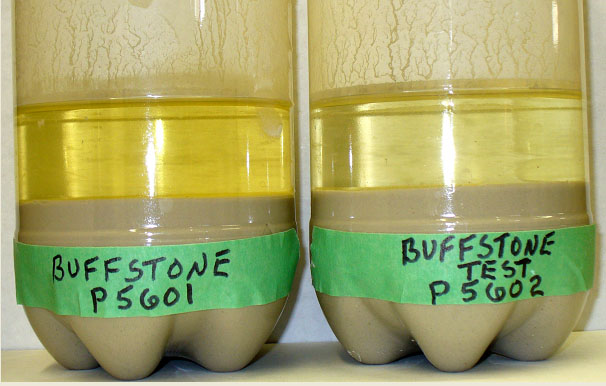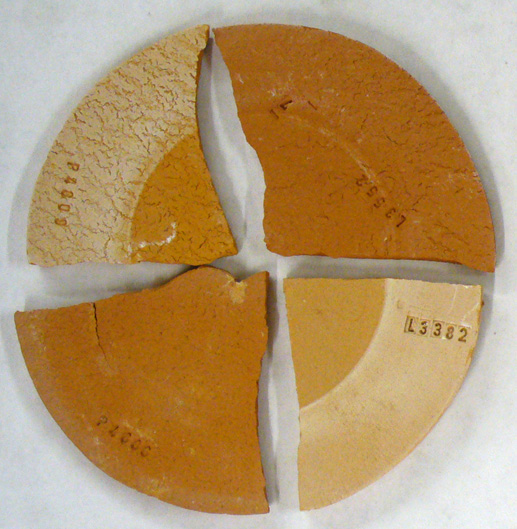| Monthly Tech-Tip | No tracking! No ads! | |
Efflorescence
A common problem with dry and fired ceramic. It is evident by the presence of a light or dark colored scum on the dry or fired surface.
Key phrases linking here: efflorescence - Learn more
Details
A term describing the whitish or brownish dry or glassy scum (depending on iron content and firing temperature) left on the surface of a fired clay body (most often red earthenware or raw stoneware and fireclays). Many clays contain soluble sulphates that migrate to the surface with the water and are left there after it has evaporated. This can happen during initial drying after forming (during manufacture) or it can happen later after the clay is fired and subjected to repeated wet-dry cycles in use (e.g. brick). Efflorescence is an issue that has always plagued the brick and tile industries. The problem can be dealt with using additions of barium carbonate (e.g. 0.2-0.5%) to precipitate the salts (barium carbonate and calcium sulphate react to yield barium sulphate and calcium carbonate, both of which are insoluble). Soluble salts can also be removed by slurrying a clay using excess water, allowing it to settle and pouring off the stained water (and repeating as necessary).
Related Information
The magic of a small barium carbonate addition to a clay body

This picture has its own page with more detail, click here to see it.
Two bisqued terracotta mugs demonstrate efflorescence. The clay on the right has 0.35% added barium carbonate (it precipitated the natural soluble salts dissolved in the clay and prevented them from coming to the surface with the water and being left there during drying). The process is called efflorescence and is the bane of the brick and terra cotta tile industries. The one on the left is the natural clay. The unsightly appearance is fingerprints from handling the piece in the leather-hard state, the salts have concentrated in these areas (the other piece was also handled).
Which clay contains more soluble salts?

This picture has its own page with more detail, click here to see it.
Example of sedimentation test to compare soluble salts water extracts from suspended clay. This simple test also reveals ultimate particle size distribution differences in clays that a sieve analysis cannot do.
How bad can efflorescence on terra cotta be?

This picture has its own page with more detail, click here to see it.
Like this! This terra cotta clay matures to good strength around 1950F. Notice how the soluble salts have concentrated on the outer and most visible surface. The piece was dried upside down so, of course, all the water had to escape through that route. A complicating factor is how handling of the piece at the leather hard stage has made it even more unsightly. This problem is common in many terra cotta materials but can also surface in others. A tiny addition of barium carbonate can precipitate the salts inside the clay matrix so they do not come to the surface on drying.
Various cone 10R clays with soluble salts on the surface

This picture has its own page with more detail, click here to see it.
These disks concentrate the solubles on the outer edge (because of the way they are dried). Soluble salts can enhance the visual appeal of a fired clay but they can also do the opposite.
A typical DFAC drying disk of an iron stoneware clay

This picture has its own page with more detail, click here to see it.
The center portion was of this DFAC test disk was covered and so it lagged behind during drying, setting up stresses that caused the disk to crack. This test is such that most pottery clays will exhibit a crack. The severity of the crack becomes a way to compare drying performances. Notice the test also shows soluble salts concentrating around the outer perimeter, they migrated there from the center section because it was not exposed to the air.
Soluble salts on a range of different cone 6 fired clay brown/tan bodies

This picture has its own page with more detail, click here to see it.
The concentrations are not serious and are typical of what you might find on a commercial body.
Soluble salts on cone 04 terra cotta clay bodies

This picture has its own page with more detail, click here to see it.
Low temperature clays are far more likely to have this issue. And if present, it is more likely to be unsightly. The salt-free specimens have 0.35% added barium carbonate.
A sculpture bodies gets a lot more interesting surface

This picture has its own page with more detail, click here to see it.
This is an example of how soluble salts can enhance the appearance of the fired surface of a cone 10R clay. This sculpture body is a vitreous dark brown burning base having lighter colored 20 mesh grog particles. The one on the left uses native stoneware clays that contain natural flux-containing solubles that migrate to the surface during drying. When fired they act like an extremely thin layer of glaze, producing a darker sheen on the surface. The thickness (and thus color) varies with contour and exposure of the surface during drying. The inside of the cone has no solubles at all.
Ravenscrag Saskatchewan clays fired at cone 10R

This picture has its own page with more detail, click here to see it.
Glazeless (top) and with glaze (bottom): A1 (bentonitic), A2 (ball clay), A3 (stoneware), 3B (porcelains), 3C (lignitic ball clay), 3D (silt). The bottom row has also shows soluble salts (SOLU test).
Soluble salts on a porcelain mug are causing plucking

This picture has its own page with more detail, click here to see it.
Fired to cone 10R. The porcelain contains bentonite and a plastic kaolin, both are contributing iron-stained solubles that come to the surface during drying. They tend to concentrate on this foot ring. The solution is to employ a little barium carbonate in the porcelain recipe to precipitate the salts. These could also be sponged or sanded off in the dry state.
Plucking in a cone 10R stoneware body having soluble salts

This picture has its own page with more detail, click here to see it.
The soluble salts have formed the brown coloration on the bare clay foot ring. While the actual salts layer is very thin, it is glassy and enough to glue parts of the base to the kiln shelf (the latter did not have adequate kiln wash or sand). The glaze line is close to the foot and this complicates the problem. There are a couple of solutions. Sand the foot ring at the dry stage to remove the soluble salt layer. Use a more refractory kiln wash that offers a powdery, non-stick surface.
Silicone sealer for porous ceramic for outdoor use

This picture has its own page with more detail, click here to see it.
This is a common sealer available at a hardware store. I have dipped the terra cotta tile and it has dried. The surface of the dipped portion is smoother. It also has a slight sheen and better red color. This sealer even makes it possible to use a porous clay body for outdoors, terra cotta bricks have long be protected against freeze-thaw spalling using products like this.
Acid products are available to remove efflorescence from ceramic surfaces

This picture has its own page with more detail, click here to see it.
Products like this are available at hardware stores. After you have removed the surface scum, be sure to seal it using a sealer (also available at hardware stores).
Inbound Photo Links
 OM4 Ball clay fired from cone 10R (top), 10 down to 4 (downward) |
 Fired bars of a bentonite used in porcelains! Is this possible? |
 Brown soluble salts that appear after drying, but disappear on firing |
Links
| URLs |
http://en.wikipedia.org/wiki/Efflorescence
Efflorescence at Wikipedia |
| Hazards |
Barium Carbonate in Clay Bodies
Considerations regarding the use of barium carbonate in pottery and structural clay bodies for precipitation of soluble salts. |
| Minerals |
Gypsum
Gypsum is hydrated calcium sulphate, CaSO4 2H2O. It is the crystalline mineral from which plaster is |
| Minerals |
Selenite
A transparent crystal form of the mineral gypsum. This can occur in clays and is the cause of efflor |
| Glossary |
Clay
What is clay? How is it different than dirt? For ceramics, the answer lies on the microscopic level with the particle shape, size and how the surfaces interact with water. |
| Glossary |
Sulfate Scum
|
| Glossary |
Water in Ceramics
Water is the most important ceramic material, it is present every body, glaze or engobe and either the enabler or a participant in almost every ceramic process and phenomena. |
| Glossary |
Soluble Salts
In ceramics, certain compounds in clays and glazes can dissolve into the water, then on drying these are left on the surface. |
| Glossary |
Sulfates
Soluble sulfates in clay produce efflorescence, an unsightly scum that mars the fired surface of structural and functional ceramic products. |
| Articles |
Soluble Salts in Minerals: Detailed Overview
There are a wide range of soluble materials that can be in clay, this article enumerates them, provides procedures on identifying and measuring them and outlines what to do about the problem. |
| Articles |
How to Find and Test Your Own Native Clays
Some of the key tests needed to really understand what a clay is and what it can be used for can be done with inexpensive equipment and simple procedures. These practical tests can give you a better picture than a data sheet full of numbers. |
| Tests |
Soluble Salts
Evaluate and compare the solubles salts content in clay bodies and materials |
| Tests |
Drying Factor/Water Content/Solubles
|
| Materials |
Barium Carbonate
A pure source of BaO for ceramic glazes. This is 77% BaO and has an LOI of 23% (lost at CO2 on firing). |
| By Tony Hansen Follow me on        |  |
Got a Question?
Buy me a coffee and we can talk

https://digitalfire.com, All Rights Reserved
Privacy Policy
